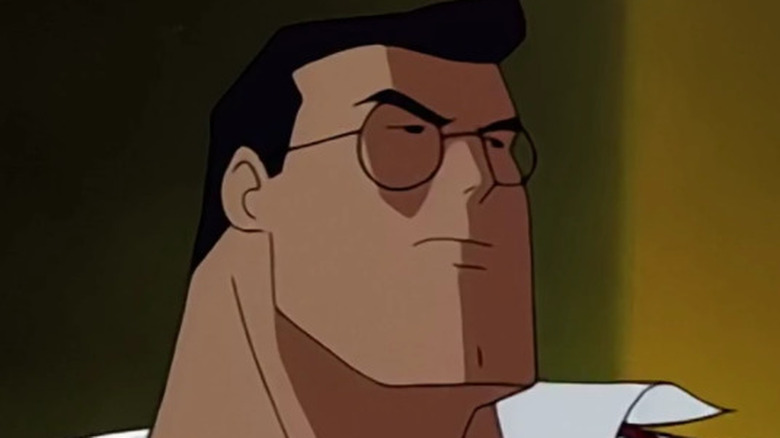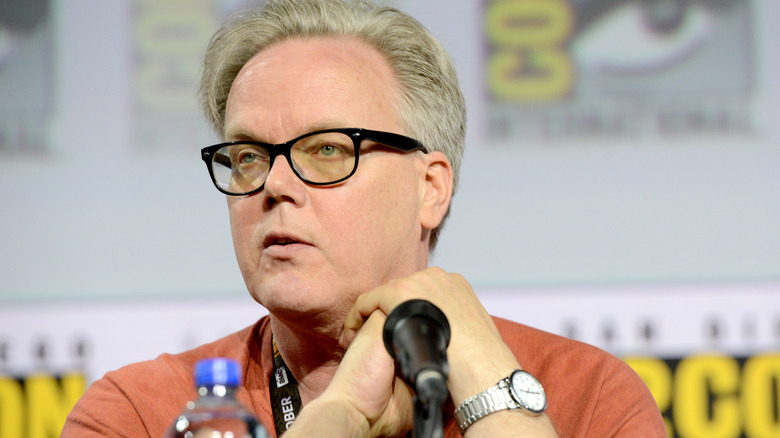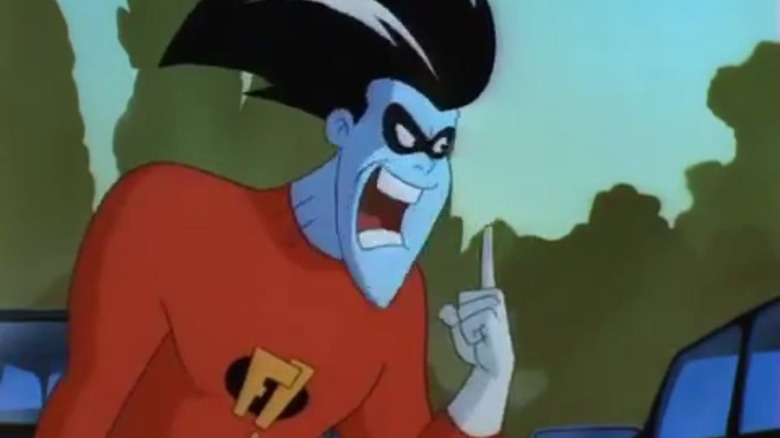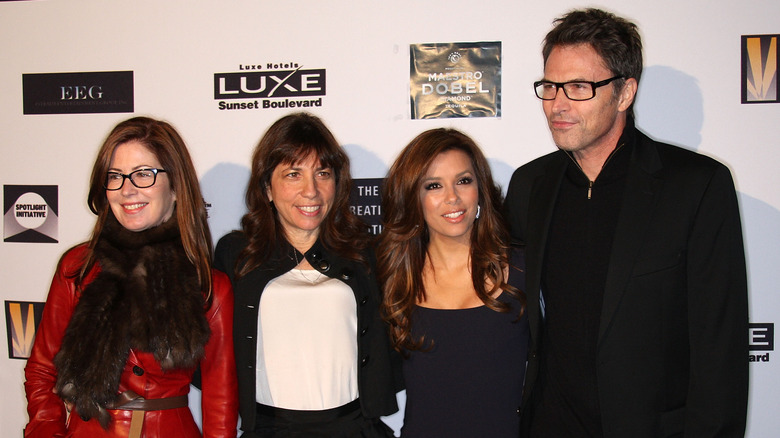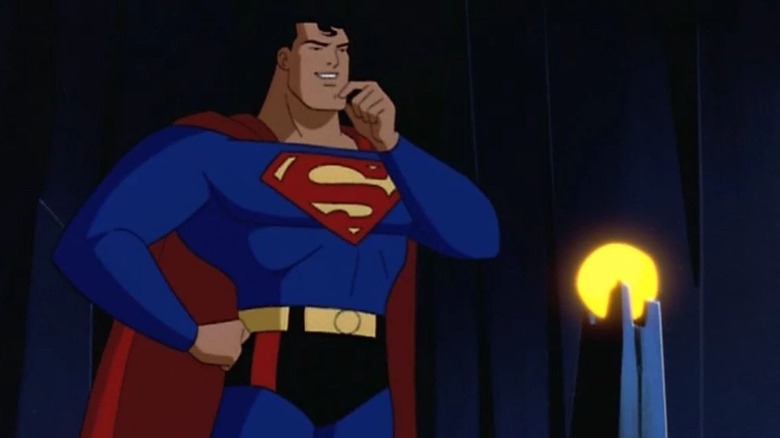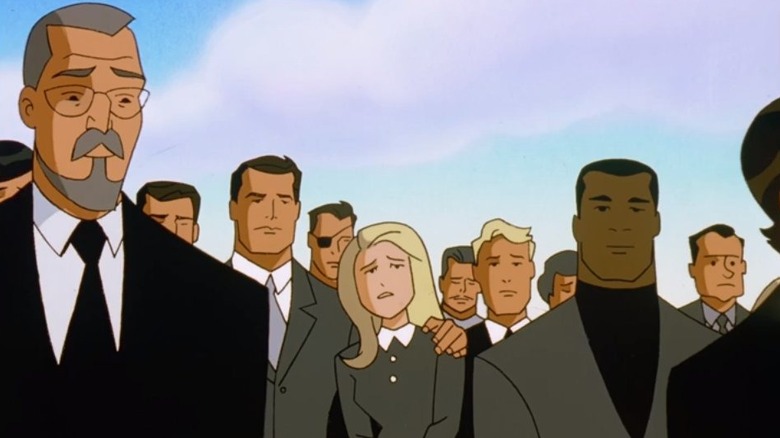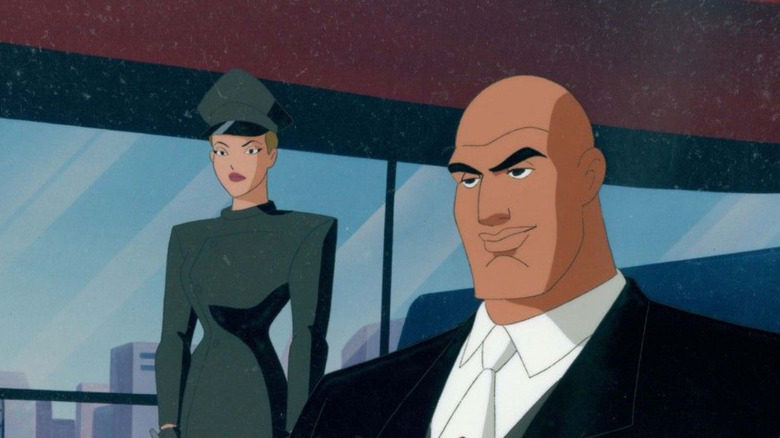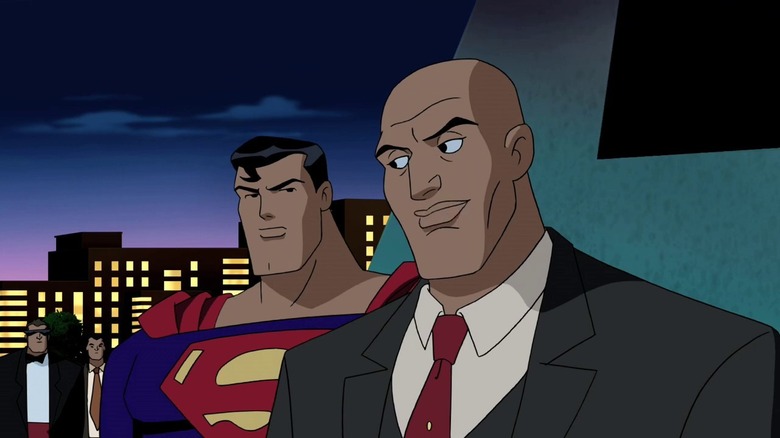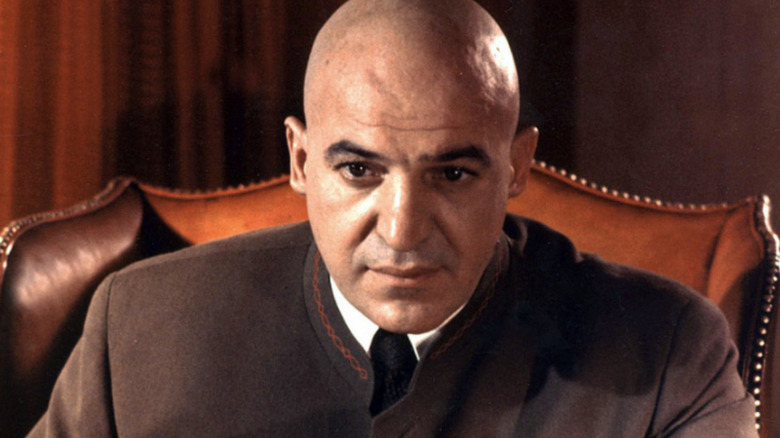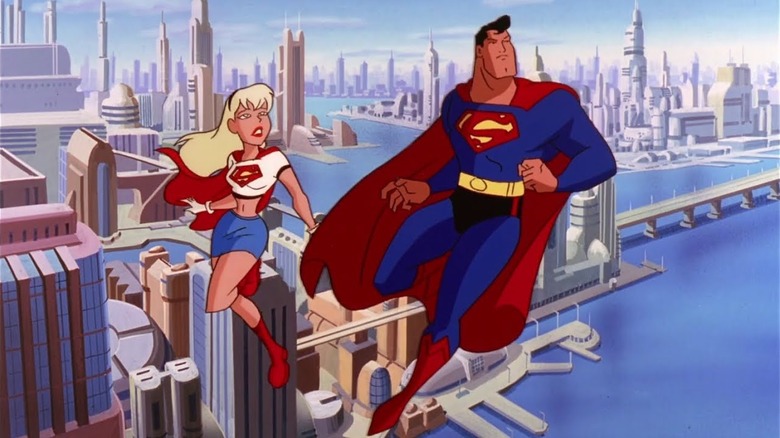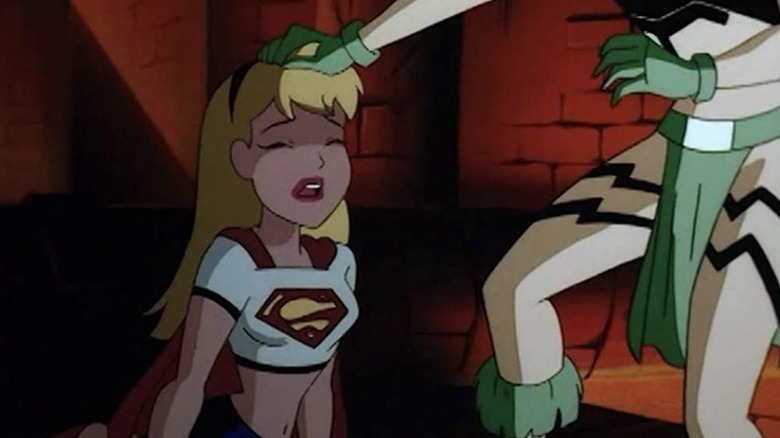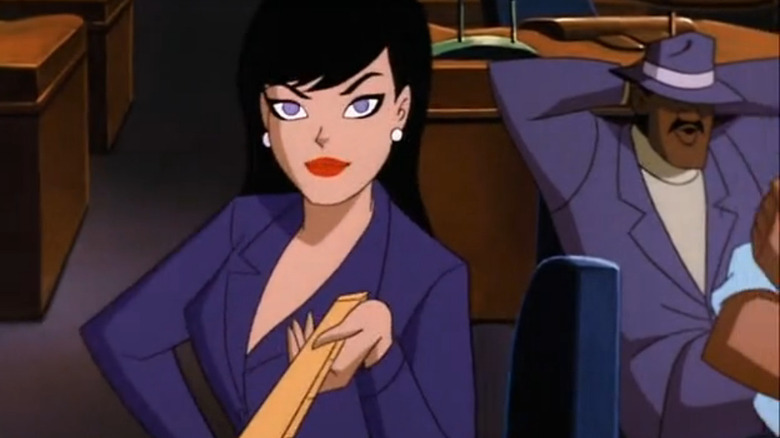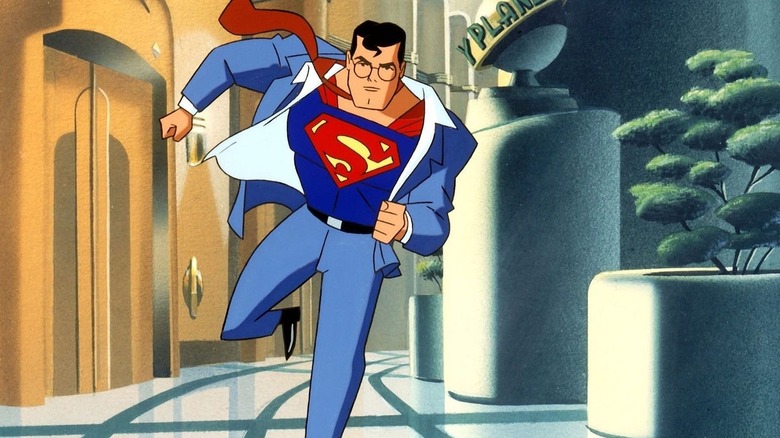The Untold Truth Of Superman: The Animated Series
Despite being one of the most iconic characters in pop culture history, DC Comics' Superman has often struggled to get his stories told in different mediums. The last live-action movie about the Man of Steel to receive universal acclaim was 1978's "Superman: The Movie" starring Christopher Reeve and Gene Hackman. And we have yet to get a "Superman" video game that comes close to the popularity of Batman's "Arkham" series.
When it comes to cartoons, Superman has a slightly better track record. From the 1940s animated series by Max Fleischer to the "Super Friends" cartoons of the 1970s, the Last Son of Krypton was a prominent part of DC's cartoon offerings. Then came "Superman: The Animated Series" (1996-2000), developed by Bruce Timm and Alan Burnett after the success of Timm's iconic "Batman: The Animated Series."
"Superman: The Animated Series" took the Man of Steel out of his old-fashioned roots and brought him into the modern era. Gone was the bumbling Clark Kent of old, the over-the-top villains, and the simplistic storylines of yesteryear. The show was applauded for turning Superman into a serious figure who could believably exist in the same reality as the gritty and grounded Batman, paving the way for the early 2000s "Justice League" cartoon and "Justice League Unlimited." Here are some lesser-known facts about "Superman: TAS" that fans need to know.
Is Bruce Timm a Superman fan?
When "Superman: The Animated Series" first aired, it was quite clear that its creator Bruce Timm had made some strong choices to make his take on Superman different from what had come before. This new version of the Man of Steel seemed less strong, less prone to smiling or laughing, and would often be seen getting the worst of a physical exchange with a villain (and even Batman).
Some fans suspected that Timm's handling of the character indicated a dislike for the Man of Steel. While talking about his desire to update the character for the cartoon series, Timm told Comicology, "Superman's just not as intrinsically cool as Batman." He went on to add, "The DC guys'll tell you the same thing — they have a very hard time making [Superman] seem fresh and exciting. He's just been around for so damn long."
However, Timm clarified on the Anime Superhero (previously ToonZone) forums in 2004 that he actually is a Superman fan, stating, "I've loved, respected and admired Superman since I was a kid ... if I had to choose one over the other, sure, I'd pick Batman in a heartbeat; it doesn't mean I don't like Superman, too; I just like Batman BETTER." Furthermore, Timm wrote that he is proud of what he and his collaborators achieved with "Superman: The Animated Series" — staying true to Superman's mythology from the comics while putting a fresh spin on his world in a way that felt new and compelling.
From Freakazoid to Superman
It's clear from Bruce Timm's comments that he wasn't particularly interested in making a show about Superman. So how did he get to the point where he got put in charge of "Superman: The Animated Series?" Turns out it had something to do with legendary Hollywood filmmaker Steven Spielberg.
Timm was amazed when Spielberg personally reached out to him to express admiration for "Batman: The Animated Series" and suggested they work together on a new show. Elated, Timm came up with "Freakazoid!," a series about a teen superhero who gains all the information on the internet. While Spielberg liked the concept for the show and acted as its executive producer, Timm did not like that his serious premise for the series was ultimately turned into a flat-out comedy.
As a result, he stepped away prematurely from "Freakazoid!" and found himself sitting around the office with absolutely nothing to do. "One day I had a meeting with my boss, Jean McCurdy," Timm explained to Comicology. "After Freakazoid, it was like, 'Yes! I want to do Superman cartoons!' I didn't even have to think about it." It may not have been a typical kind of inspiration, but it's certainly interesting to see how a master like Spielberg indirectly pushed Timm into helming "Superman: The Animated Series."
The funniest part of voicing the characters
One major change that Bruce Timm made to Superman was to make the character significantly less powerful than previous versions. In order to add tension to the action scenes, Superman was often shown struggling to overcome a powerful enemy or lifting heavy objects. In those moments, Superman can be heard grunting or panting from the physical effort involved.
While such sounds added to the dramatic tension of the scenes, recording them was far from a serious affair. In fact, Dana Delany, who voiced Lois Lane on the show alongside Tim Daly's Clark Kent/Superman, considered recording these scenes to be the funniest part of the job. "My memory of Tim Daly is grunting and groaning," Delany said in an interview with DC Comics. "He and I had the hardest time getting through recording sessions."
According to Delany, a major part of Daly's job was to issue all sorts of grunts and groans while recording his scenes for the Man of Steel. "We were always joking about how it sounded like he was on the toilet," Delany said. As ridiculous as the recording sessions must have been, Daly put his heart and soul into each anguished grunt and groan, really conveying the idea of a Superman who has to struggle to pull off his amazing feats of strength.
Inspired by Hercules
It is a well-known fact that one of the many sources of inspiration behind the creation of Superman in the comics was the legend of Hercules, the Greek god of strength and heroes. Over time, Superman's nature diverged from Hercules a great deal, to the extent that the two characters actually came to blows when they met in the comics.
Still, Hercules proved to be yet another source of inspiration when Bruce Timm was trying to decide on his version of the Man of Steel in "Superman: The Animated Series." Fans noted when the show was first released that its take on the lead character looked unlike any past version of Superman from the comics or cartoons.
This was a deliberate choice on the part of Timm to differentiate his Superman from those that had come before. While figuring out the character design for the hero, Timm was inspired by the drawing style of a 1963 animation series called "The Mighty Hercules." The team behind "Superman: TAS" took their cues from the series to design Superman's prominent jawline and square build.
A tribute to a Marvel legend
Many fans take the rivalry between DC and Marvel Comics quite seriously. But the truth is, the two companies have long employed many of the same artists, and there is a great deal of camaraderie between the creators of the comics and cartoons of both companies. For instance, Marvel Comics legend Jack Kirby is just as deeply respected by the folks over at DC as he is at his own company, having created characters for them like the New Gods.
Bruce Timm was such a fan of Kirby's that he modeled the look of Dan Turpin in "Superman: The Animated Series" after him, and the tribute did not end there. The episode "Apokolips...Now! Part II" features a funeral scene for Turpin. The scene pays homage to the many popular Marvel characters that Kirby created in his time, with some of them shown to be present at the funeral, alongside Kirby's real-life colleagues in the comics industry.
"I'm happy to say my father and I got animated into the funeral sequence of that episode," celebrated comics artist Alex Ross states in The Krypton Companion. "They also had characters like the out-of-costume Fantastic Four [from Marvel], Orion, Big Barda, and Mr. Miracle–countless characters and professionals [from Kirby's career]." Unfortunately, likely due to copyright issues, the well-known characters were replaced with nondescript stand-ins when the episode aired during reruns, but the original scene can still be found on YouTube.
The status of Mercy Graves
Bruce Timm was instrumental in creating the Joker's primary henchwoman/love interest Harley Quinn for "Batman: The Animated Series" — a character who subsequently became so popular that she was added to the official comics canon and even got her own movie and television series (per Vulture). A lesser-known fact is that Timm did the same thing for "Superman: The Animated Series" with the creation of a new character called Mercy Graves. Like Harley, Mercy is shown to be Lex Luthor's right-hand woman. The character generated sufficient interest to be added to the comics, and she later showed up in several live-action adaptations.
One of the big questions surrounding Mercy has always been whether or not she is romantically involved with Lex like Harley is with the Joker. While Mercy is always the first one on hand whenever Luthor needs someone to execute his nefarious schemes, he appears to keep her at arm's length most of the time. Clancy Brown, the actor who voiced Luthor on the show, does not believe his character had a romantic relationship with Mercy. "I don't think Lex indulges in any libido," Brown stated in an interview with DC Comics. "I don't think there's any romance going on. I think he sees [Mercy] simply as an assistant, although she sees herself as something more. Not a lover, but a student or apprentice." Conversely, in Part 2 of the "Justice League" episode "Tabula Rasa," Luthor seemingly implies that his relationship with Mercy was at times physically intimate, though it's never confirmed.
Luthor almost voiced Superman
While Lex Luthor's distinctive and imposing look was a big part of the character's popularity on "Superman: The Animated Series," another major component of his appeal was his deep, commanding voice that could go from icy calm to terrifying anger at the drop of a hat. Veteran actor Clancy Brown was the one chosen to bring Luthor's voice to life on the show, and he does a spectacular job.
While Brown has made a career out of playing all sorts of terrifying bad guys, he was looking to change things up when he went in to audition for "Superman: TAS." In fact, Brown originally auditioned to voice the role of Superman because he wanted to move on to playing good guys. "[During the audition] I went in there and read for Superman," Brown revealed in an interview with DC Comics. "As I was packing up to leave, [voice director] Andrea Romano asked if I minded reading for Lex Luthor."
At first Brown was resistant to the idea of playing the villain once again, so much so that Romano did not press him any further to read for Luthor and simply thanked him for coming in. In the end, though, Brown decided to take a try at Lex, wanting to be involved in the show however he could. "I was just frustrated because every time I try to be the good guy, I end up being the bad guy," he admitted.
A James Bond connection
Lex Luthor is the most iconic Superman villain of all time. The genius businessman and crime lord has been depicted in a number of ways over the years. Sometimes he is old, grossly fat, and bald, and sometimes he is young and lean with long red hair. But arguably the most popular depiction of Luthor was in "Superman: The Animated Series."
On the show, Luthor was seen to be a towering presence. Not only was he very tall, but he was also broad-shouldered, with a distinctive nose and a bald head. Luthor looked like someone who could actually stand up to the Man of Steel despite being a normal human. To create his iconic look, the makers of the show looked to another iconic villain from the past.
On the show's DVD commentary features, it is revealed that Luthor's look was partly based on actor Telly Savalas, who's most famous for playing Lieutenant Theo Kojak in the 1970s series "Kojak" and for portraying "James Bond" villain Ernst Stavro Blofeld in the movie "On Her Majesty's Secret Service." Much like Luthor, Blofeld is a criminal mastermind who depends more on brains than brawn (as well as an army of henchmen) to stay two steps ahead at all times. Savalas played the character and other similar roles expertly throughout his career, so he was definitely a great place to start when building the new Luthor.
A changed Supergirl
While "Superman: The Animated Series" generally tried to hew close to the mythology from the comics, there were times when the makers of the show had no choice but to strike out in new directions. One such moment occurred when talks began about adding Supergirl to the show.
"[Adding] Supergirl was something we wanted to do from very early on." Bruce Timm revealed in an interview. "She's a big part of the mythos from the comics. We figured we'd have to get around to her eventually someday." But while the network welcomed the idea of adding Supergirl to the show, they handed down one mandate with regards to the character — that she could not also be from Krypton like in the comics, since Superman was supposed to be "The Last Kryptonian."
Due to the mandate, Supergirl's backstory was altered slightly for the show. The character was shown to hail from Krypton's sister planet Argo, which was a reference to "Argo City," the place on Krypton where Supergirl was born in the comics. The creators of the show also noted that the network wanted Supergirl to have a different set of powers from Superman, but that part of the mandate was largely ignored, and Supergirl ended up having most of the same abilities as the Man of Steel.
The episode that went too far
One thing that "Superman: The Animated Series" was particularly praised for was taking the more fantastic elements of the comic villains and grounding them in something approaching the real world. While this trend was embraced for much of the series' run, there was one particular episode that may have edged too far into the real world. That would be the two-part episode "Little Girl Lost" in Season 3, which involved the alien supervillain Granny Goodness making use of a gang of teenagers to carry out nefarious activities on Earth.
The version of the episode that ended up on TV was much tamer than what its writers had originally planned. "The second half [of the episode] was changed fairly last minute and a regular series writer reworked the plot," writer Evan Dorkin revealed to Toon Zone News (via DC Animated). "Originally, Granny Goodness was bringing together wayward teens and training them with Apokolips technology because she was harvesting them as source material for creating new Parademons."
The original script for the episode featured a Nazi concentration camp-style set piece where innocent civilians are transformed into soulless Parademons to join Darkseid's army as his foot soldiers. According to Dorkin, after signing off on the original script, one of the producers of the show later balked at the idea of showing such gruesome imagery, and a host of new writers were brought in to tone down the content.
The inspiration behind Lois Lane
One of the most popular characters on "Superman: The Animated Series" was Lois Lane, voiced by Dana Delany. This version of Lois was strong, confident, and much more than a damsel in distress. The working relationship between Lois and Clark as investigative reporters was emphasized much more than Lois' romance with Superman, and that gave her a great deal more to do than flirt with the Man of Steel.
Delany's voice acting in the role of Lois was a major part of the characters' appeal. Not only did Delany have great chemistry with Superman voice actor Tim Daly, but the actress brought a great deal of strength and personality to Lois' voice, making her a woman who could keep even the Man of Steel on his toes. While Delany had grown up watching Lois Lane on TV and in the comics, there was one particular performance from another actress that she based her version of Lois on.
"[Lois is] really fast-talking but in a timeless way," Delany explained in an interview with Screen Rant when talking about her approach to the character. "I modeled her off of Rosalind Russell from the movie 'His Girl Friday,' who was a fast-talking reporter, and that really worked for the character. Lois just kept moving, no matter what."
Superman almost had a mullet
As mentioned before, the Man of Steel has always been a difficult character to think up stories for. Superman has been the subject of countless changes and reinventions, not just across shows and movies, but also in the comics where he got his start. One such reinvention in the '90s somehow ended up with comic book Superman sporting a mullet, while Clark Kent kept his hair tied up in a ponytail.
The reactions to Superman's new look were deeply mixed. But DC doubled down on the mullet and insisted it was there to stay. The company even asked Bruce Timm to give the lead character in "Superman: The Animated Series" a mullet as well. "I was like, "No effing way am I giving him a mullet!" Timm revealed in an interview with Screen Rant. "And [the heads at DC Comics were] like, 'Oh but this isn't just a flash in the pan, this is gonna be his look from now and forever' and I'm like, 'No, it's not. A year from now he'll be back with his short hair. I know it.'"
Timm stuck to his guns, eventually bringing the issue before Warner Bros. CEO Bob Daly, who allowed the showrunner to keep Superman's more traditional cut. In the end, Timm's premonition turned out to be correct, and the Superman of the comics eventually reverted to his short hairstyle.
